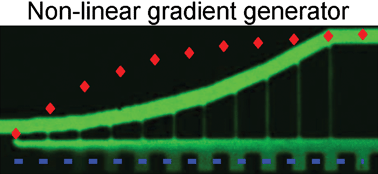Generation of linear and non-linear concentration gradients along microfluidic channel by microtunnel controlled stepwise addition of sample solution†
Abstract
The ability to generate stable chemical gradients in microfluidics has important applications, since such gradients are useful in both chemical and biological studies. Growing evidence reveals that many cellular responses are specific to non-linear spatial gradients, hence a need to control complex concentration gradient profiles with and within microfluidics. In this paper, we present a structure-based approach to generate linear and non-linear chemical gradients, with profiles controlled by microtunnels fabricated alongside two main channels. Using single-step


 Please wait while we load your content...
Please wait while we load your content...